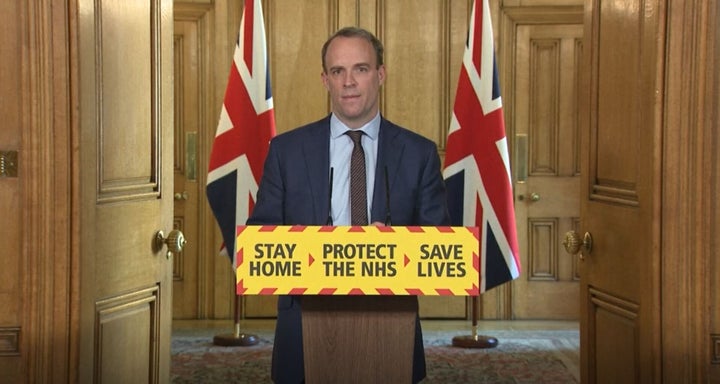
You’re reading The Waugh Zone, our daily politics briefing. Sign up now to get it by email in the evening.
R we being served?
Dominic Raab’s No.10 press conference was meant to be a holding event, the tantalisingly light hors d’oeuvres before the British beef of Boris Johnson’s main course. But thanks to a combination of academic number-crunchers and devolved government leaders, the dinner party didn’t quite go as planned.
When he got up for his pre-bank holiday briefing, the first secretary clearly wanted a steady-as-she-goes message. Any changes to England’s current coronavirus lockdown would be “modest, small, incremental and very carefully monitored”, he said. When the PM addressed the country on Sunday, he would set out “appropriate measures to be taken at appropriate milestones, subject to very clear conditions”, he added.
Raab was so keen to smooth the path for his boss’s modest good news that he seemed to forget at first to announce that in fact he was formally (as required by law) extending the current lockdown, at least for another three days. He was frank enough to repeat that making “even the smallest of changes to the current guidance will be a point of maximum risk”. Yet it was when he started appearing to play down that risk that things started to get messy.
Raab revealed that the R (the reproduction number for the virus’s transmission rate from person to person) now stood at “between 0.5 and 0.9”. That 0.5 is the lowest that any government figure has given since this whole crisis began, so it felt like good news. So good that perhaps it creates space for the PM to credibly talk about those small returns to normality.
Yet national statistician Sir Ian Diamond, on his debut at these No.10 events, proceeded to give us the bad news. That upper estimate of 0.9 is actually dangerously close to 1, the point at which one person transmits this virus to someone else. Anything above one, as every minister has told us, means a new increase in its spread.
Diamond went further, in backing up evidence to MPs earlier by Professor John Edmunds of the London School of Hygiene and Tropical Medicine, who had revealed that the most recent figures put the R number between 0.75 and 1.0, whereas a few weeks ago it was 0.6 or 0.7.
The stats chief then effectively ruined all that careful No.10 pitch-rolling, by saying Prof Edmunds “is right that R has probably gone up just a little bit” and - wait for it - “that is driven by the epidemic in care homes”. To cap it all, Diamond said that his personal view was “social distancing and maintaining it over the next few weeks is going to be central to reducing the pandemic.” No wonder Raab tried to sweeten the pill, saying “Soooo, overall R is down. But there’s obviously, clearly a challenge that remains in care homes.”
After all that, just how can the government start easing the lockdown this weekend? How can it meet its self-imposed test that it won’t do anything unless it is ‘confident’ the changes won’t risk a second peak of infections? Even if the number of deaths in care homes is coming down (as No.10 said today), a rising infection rate looks very worrying indeed.
Well, perhaps it’s all to do with the caveat to that test, doing nothing to risk “a second peak of infections that overwhelms the NHS”. First, the NHS has not been overwhelmed even during the worst of the crisis in early April (though it was close). And second, a new rise in R would result in tighter restrictions to quickly get things back under control, Raab made clear.
That rationale clearly hasn’t convinced the governments in Scotland or Wales. Nicola Sturgeon this morning made another three-week extension of the lockdown her main message, adding that dumping the ‘Stay Home’ mantra too soon would be “potentially catastrophic mistake”. Then the Welsh education minister added its schools would definitely not be opening on June 1, despite some reports that English pupils would start to go back then.
Of course, one of the main reasons for the PM’s push to ease the lockdown is pressure from the chancellor, many Tory MPs and employers for the economy to get going again. Today’s Bank of England study suggested an eye-watering 14% drop in GDP this year, but followed by the fastest, biggest recovery for hundreds of years. Even Rishi Sunak’s title for one of his interventions, ‘bounceback loans’, presupposes some kind of bungee-jump for firms and their staff.
But that ‘V-shaped’ recovery forecast is not shared by everyone. As former chancellor Alistair Darling pointed out, this could be a long haul, with higher unemployment possible for years. A sustained downturn would not just be an economic blow, it would be a political danger too for this government, despite its big majority. Even the Bank of England talked of long term ‘scarring’.
Communities secretary Robert Jenrick was right to warn yesterday that the towns that voted Brexit and vote Tory in the north and midlands “are exactly the sorts of communities and economies that are likely to be most hit by the economic disruption”. It’s hard to ‘level up’ skills and investment if this virus is driving things downwards.
With VE Day’s 75th anniversary marked tomorrow, it feels as if Boris Johnson wants to follow it up with the first hint of a VE-shaped recovery, full of Brexit bravura and British exceptionalism.
One problem with that messaging is that it took decades for the UK to recover from the Second World War, (with rationing in place for nine years after its end). The other is that Germany ‘won the peace’ with an economy that outpaced ours. And now with a lower death rate from this awful common enemy, it’s Berlin that may ‘bounce back’ quicker than us once more.
Quote Of The Day
“We are not going to do anything that risks a second peak. We will advance with maximum caution in order to protect the NHS and to save lives.” - Boris Johnson to his Cabinet
Thursday Cheat Sheet
30,615 people in the UK have now died from coronavirus, up 539 on the previous day.
Some 86,583 people were tested for the virus on Wednesday, up on recent days but still the fourth day running that Matt Hancock’s 100,000-a-day target has not been met. Deputy chief medical officer Jenny Harries pointed to technical problems with a lab that had now been resolved.
With many people expected to flock outdoors this weekend, No.10 had to deal with the mixed messaging of telling them not to sunbathe just hours after newspaper front pages declared the the public could indeed spend more time outdoors from next Monday.
The economy could contract by 14% and unemployment could double as the Covid-19 pandemic plays out throughout the country, the Bank of England suggested.
Black people are four times more likely to die from COVID-19 than white people in England and Wales, a new ONS analysis of mortality records found.
Labour extended by a week the time its NEC will have before choosing a new general secretary, on Tuesday May 26.
The NASUWT teachers union signalled that it did not want schools in England to return before September, citing safety fears for staff.
What I’m Reading
Got A Tip?
Send tips, stories, quotes, pics, plugs or gossip to waugh.zone@huffpost.com.
Subscribe To Commons People
Each week, the HuffPost UK Politics team unpack the biggest stories from Westminster and beyond.
Shadow culture minister Tracy Brabin joins us this week. Hear us chat through lockdown timings, ‘pina colada’ furloughs and no-drama Starmer’s big challenge. Click HERE to listen on Audioboom. Search for Commons People wherever you listen to podcasts and subscribe.
